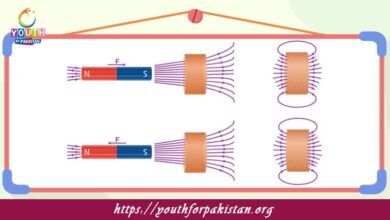Atomic Sizes MDCAT MCQs with Answers

Welcome to the Atomic Sizes MDCAT MCQs with Answers. In this post, we have shared Atomic Sizes Multiple Choice Questions and Answers for PMC MDCAT 2024. Each question in MDCAT Chemistry offers a chance to enhance your knowledge regarding Atomic Sizes MCQs in this MDCAT Online Test.
The atomic size of an element generally increases as you move:
a) From left to right across a period
b) Down a group
c) Up a group
d) From right to left across a period
Which of the following elements has the smallest atomic size?
a) Helium (He)
b) Neon (Ne)
c) Argon (Ar)
d) Krypton (Kr)
Among the following elements, which has the largest atomic size?
a) Lithium (Li)
b) Sodium (Na)
c) Potassium (K)
d) Rubidium (Rb)
The atomic size of an element in the same group generally:
a) Increases from top to bottom
b) Decreases from top to bottom
c) Remains constant
d) Varies unpredictably
The atomic size of an element in the same period generally:
a) Decreases from left to right
b) Increases from left to right
c) Remains constant
d) Varies unpredictably
For isoelectronic ions, the size of the ion:
a) Increases with increasing nuclear charge
b) Decreases with increasing nuclear charge
c) Remains constant
d) Varies unpredictably
The atomic size of potassium (K) compared to calcium (Ca) is:
a) Larger
b) Smaller
c) The same
d) Not comparable
The atomic size of an atom is influenced by:
a) The number of protons
b) The number of neutrons
c) The number of electrons
d) All of the above
Which of the following elements has the largest atomic size?
a) Carbon (C)
b) Silicon (Si)
c) Germanium (Ge)
d) Tin (Sn)
The atomic size of an element is generally larger for:
a) Cations compared to their neutral atoms
b) Anions compared to their neutral atoms
c) Neutral atoms compared to their cations
d) Neutral atoms compared to their anions
The atomic size of an element in the same period as oxygen is generally:
a) Larger for elements to the left
b) Larger for elements to the right
c) The same for all elements
d) Unpredictable
The atomic size of chlorine (Cl) compared to bromine (Br) is:
a) Larger
b) Smaller
c) The same
d) Not measurable
The atomic size of an element typically:
a) Increases with increasing number of electron shells
b) Decreases with increasing number of electron shells
c) Remains constant with increasing number of electron shells
d) Varies unpredictably with increasing number of electron shells
Which of the following has the smallest atomic size in period 4?
a) Potassium (K)
b) Calcium (Ca)
c) Scandium (Sc)
d) Zinc (Zn)
The atomic size of a noble gas compared to its adjacent halogen in the same period is:
a) Larger
b) Smaller
c) The same
d) Not comparable
The atomic size of an element generally:
a) Increases with increasing number of protons
b) Decreases with increasing number of protons
c) Remains constant with increasing number of protons
d) Varies unpredictably with increasing number of protons
The atomic size of an element with a positive charge compared to its neutral atom is generally:
a) Larger
b) Smaller
c) The same
d) Unpredictable
The atomic size of an element in the f-block compared to its corresponding s-block element is generally:
a) Larger
b) Smaller
c) The same
d) Unpredictable
The atomic size of an element compared to its adjacent elements in the same group is:
a) Larger as you go up the group
b) Smaller as you go up the group
c) The same across the group
d) Varies unpredictably
Which of the following elements has the largest atomic size in period 2?
a) Lithium (Li)
b) Beryllium (Be)
c) Boron (B)
d) Carbon (C)
The atomic size of an element in the p-block compared to an element in the s-block of the same period is generally:
a) Larger
b) Smaller
c) The same
d) Not comparable
The atomic size of sulfur compared to phosphorus is:
a) Larger
b) Smaller
c) The same
d) Not measurable
In a group, the atomic size of an element generally:
a) Decreases from top to bottom
b) Increases from top to bottom
c) Remains constant
d) Varies unpredictably
The atomic size of an element generally:
a) Increases with increasing number of inner electron shells
b) Decreases with increasing number of inner electron shells
c) Remains constant with increasing number of inner electron shells
d) Varies unpredictably with number of inner electron shells
The atomic size of an element with a high ionization energy compared to an element with low ionization energy is generally:
a) Larger
b) Smaller
c) The same
d) Not comparable
The atomic size of an element compared to its isoelectronic species is:
a) Larger if it has fewer protons
b) Smaller if it has fewer protons
c) The same
d) Unpredictable
Which of the following elements has the smallest atomic size in period 3?
a) Sodium (Na)
b) Magnesium (Mg)
c) Aluminum (Al)
d) Argon (Ar)
The atomic size of an element generally:
a) Increases with increasing number of electrons
b) Decreases with increasing number of electrons
c) Remains constant with increasing number of electrons
d) Varies unpredictably with number of electrons
The atomic size of an element in the transition metals series compared to its group 1 counterpart is generally:
a) Larger
b) Smaller
c) The same
d) Not comparable
The atomic size of an element with a high atomic number compared to an element with a low atomic number is generally:
a) Larger if it is in the same group
b) Smaller if it is in the same group
c) The same if it is in the same group
d) Unpredictable
The atomic size of an element in the d-block compared to an element in the s-block of the same period is generally:
a) Larger
b) Smaller
c) The same
d) Unpredictable
The atomic size of neon compared to its adjacent alkali metal is:
a) Larger
b) Smaller
c) The same
d) Not measurable
The atomic size of an element in the lanthanide series compared to its corresponding main group element is generally:
a) Larger
b) Smaller
c) The same
d) Unpredictable
The atomic size of an element compared to its adjacent element in the same period is:
a) Larger for elements on the left
b) Smaller for elements on the left
c) The same for all elements
d) Unpredictable
The atomic size of an element in the periodic table can be measured by:
a) X-ray diffraction
b) Mass spectrometry
c) Nuclear magnetic resonance
d) Infrared spectroscopy
The atomic size of an element is largest when it:
a) Has the most protons and electrons
b) Has the fewest protons and electrons
c) Has the most electron shells
d) Has the fewest electron shells
The atomic size of an element in period 5 compared to period 4 is generally:
a) Larger
b) Smaller
c) The same
d) Not comparable
The atomic size of an element in period 6 compared to period 5 is generally:
a) Larger
b) Smaller
c) The same
d) Not comparable
The atomic size of an element with a higher atomic number compared to an element with a lower atomic number in the same group is:
a) Larger
b) Smaller
c) The same
d) Not comparable
In the periodic table, the atomic size generally:
a) Increases as you move down a group
b) Decreases as you move down a group
c) Remains constant across a group
d) Increases as you move across a period
If you are interested to enhance your knowledge regarding Physics, Chemistry, Computer, and Biology please click on the link of each category, you will be redirected to dedicated website for each category.





